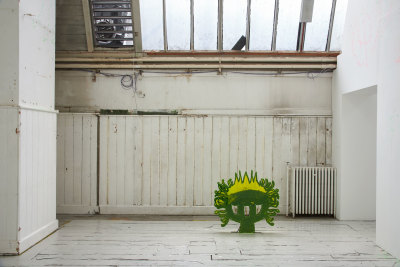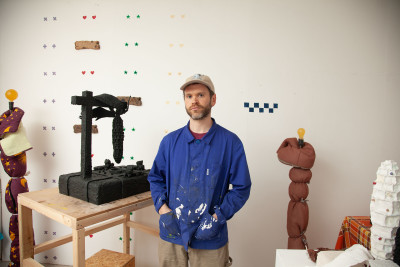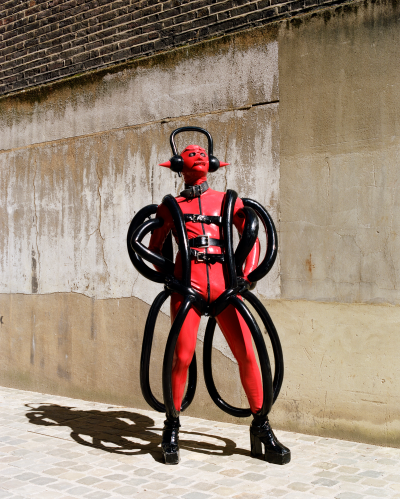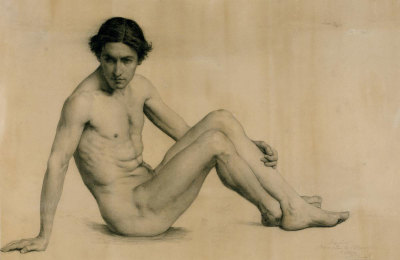Under the influence
Under the influence
By Colin Perry
Published 3 March 2014
What is in the minds of art students today? We find out what’s feeding the imaginations of RA Schools’ second-year students – and what direction their work is taking – ahead of their group exhibition in the Royal Academy’s galleries.
-
From the Spring 2014 issue of RA Magazine, issued quarterly to Friends of the RA.
The annual exhibition ‘Premiums Interim Projects’ captures a freeze-frame moment in the quickly shifting development of Royal Academy Schools’ students during the second year of their studies. Artists advance, expand and shift gear at art school like nothing else. This is particularly true at the RA Schools, where students frequently arrive having spent a number of years in the ‘real world’ after graduating, and are now returning for three years to an environment in which experimentation and risk are welcomed.
Students are offered superb atelier-like spaces, lit by long skylights that stretch down the length of the RA Schools, which is sandwiched between the main RA buildings: Burlington House and Burlington Gardens.
These students are a select bunch, with only 17 or so in each of the three years. This tends to foster a series of dialogues, confluences and aesthetic disagreements that is highly productive, introducing new elements to an artist’s practice and pushing them further along their chosen path.
What follows is a snapshot of the artists who are exhibiting in this year’s ‘Premiums’, midway through their studies. Rather than showing examples of their work, each artist has chosen an idea, object or image that constitutes part of their research material.
Within this wide remit, we can see that the artists of today enjoy muddying the boundaries between consumer culture, everyday urban and natural materials, and art history. While each artist has chosen a single idea, object or image, these are just examples of the kinds of things that occupy the artists in their studios, prompting thoughts and conversations.
What follows is a snapshot of the artists who are exhibiting in this year’s ‘Premiums’, midway through their studies. Rather than showing examples of their work, each artist has chosen an idea, object or image that constitutes part of their research material.
Within this wide remit, we can see that the artists of today enjoy muddying the boundaries between consumer culture, everyday urban and natural materials, and art history. While each artist has chosen a single idea, object or image, these are just examples of the kinds of things that occupy the artists in their studios, prompting thoughts and conversations.
-
-

Caroline Abbotts
Interest: Outer space
Research material: Photograph by Professor Phil Bland of part of a comet entering the Earth’s atmosphereCaroline Abbotts’s studio contains a relic from outer space – a meteorite, black and heavy, as if possessed of its own gravitational force. She often works in collaboration with scientists, and has spent time researching images of the solar system. Themes in her work include the connection between the micro-world (the meteorite) and the macro-world (the universe). Interested in photographic processes, Abbotts has propped up against her studio wall several glass sheets that show negative images of the starry sky taken from Earth’s north celestial pole. For this ambitious work the glass sheets had been immersed in huge developing tanks containing photographic fluids.
-

Rebecca Ackroyd
Interest: Window displays
Research material: A window with mesh grill, which distorts the view behindRebecca Ackroyd’s work is invested in the allusive quality of things: her sculptures are partly inspired by everyday window displays, from those of shops to domestic apertures that display curtains and plants. In her studio space she is creating a tall, curved, freestanding panel on which a close-up image is printed of a luxurious-looking white bath towel. While Ackroyd’s work may be sculptural, some of her other influences are literary. She is currently interested in the American Imagist poet Hilda Doolittle (1886-1961), known as H.D, whose writing was concerned with the power of simple objects to convey meaning.
-

Victoria Adam
Interest: Dress
Research material: Men’s overcoat, English, c.1800Victoria Adam is currently thinking about the connection between dress and morality: the idea that cloth might act as a visible code for one’s ethics. This concern is related to her interest in the history of clothing, and in particular fixings and fastenings, such as seams, lacing, buttons and zips. Her own works often deploy modest materials in unorthodox ways – for example, instead of using conventional nails or screws, Adam has used cloves and earplugs to attach thin fragments of various materials (including plaster and polystyrene sheets) to the wall. Her work has a sly (almost undetectable) sense of humour, a fertile sense of the absurd hidden in the everyday.
-
-
-

Matt Ager
Interest: Everyday materials
Research material: The form of an ice-creamMatt Ager treats all materials as equal, drawing inspiration from the composition of everyday objects – he explains, for example, how he was intrigued by the muted colour and proportion of an ice-cream he saw his friend eating. His wall-based assemblages sometimes include an item of clothing – a pair of trousers, a shirt – placed alongside other elements, such as a photograph of a spoon scooping a sugary substance, or framed drawings of a cupcake. What appears to unite these objects and images is their colour (Ager has a fondness for orange, salmon and pink). If you squint, these works might even look like an abstract painting by Barnett Newman or Mark Rothko. Ager’s work treads a line of taste, collapsing distinctions between highbrow and lowbrow.
-

Sofie Alsbo
Interest: Loops
Research material: I am a Strange Loop, 2007, by Douglas HofstadterSofie Alsbo has been reading I am a Strange Loop (2007) by Douglas Hofstadter, a book that explores the use of self-referential or ‘feedback’ systems. The idea of the ‘loop’ is clearly pertinent to Alsbo’s art. She is particularly interested in lenticular prints – think 3D postcards that change image when tilted. Alsbo has used this technique to great effect in an image she has made of a silhouetted man who appears to be running in an endless circuit. She often reuses kitsch imagery, making Romantic-looking scenes filled with deep shadows and gloaming light.
-

Hannah Bays
Interest: The cult of John Frum
Research material: The ceremonial cross of the John Frum cult, on the island of Tanna, VanuatuHannah Bays is a painter whose works explore figuration, symbolism and collage-like fragmentation. She is currently interested in John Frum, a legendary figure who gave rise to a cargo cult in the South Pacific island of Tanna, Vanuatu. By tapping into the story of Frum, Bays looks at ways in which people have sought to understand the modern, secular world in more mythic terms. Bays’s images burst with revelations, drawn from sources such as psychedelic imagery (one painting features a character shaped like a mushroom) and Jungian archetypes.
-
-
-

Josie Cockram
Interest: Psychoanalysis
Research material: The ideas of psychoanalyst Adam PhillipsJosie Cockram’s current reading list includes books by British psychoanalyst Adam Phillips, author of such leftfield titles as On Flirtation: Psychoanalytic Essays on the Uncommitted Life (1994), On Balance (2010) and Missing Out: In Praise of the Unlived Life (2012). The themes Phillips examines in these books, such as the value of relinquishing control, inform Cockram’s video installations; she does not synchronise her moving images and her soundtracks, in order to free the viewer to consider the effect of one on the other. Her videos, which feature close-up, semi-abstract footage of objects, are projected on objects in the gallery space – a tent-like structure rather than a screen in the case of her work, Pavilion (2014), in ‘Premiums’.
-

Adam Collier
Interest: The carnivalesque
Research material: François RabelaisAdam Collier makes sculptures that Rabelais would have appreciated. The French Renaissance author’s bawdy humour and fondness for excess finds its equivalent in Collier’s works, with their excrescent surfaces and cartoon-like animism. However, Collier has not been delving into Rableais’s Gargantua and Pantagruel, but rather the Russian writer Mikhail Bakhtin’s Rabelais and His World (1965), a book that analyses literary notions of the carnivalesque and the grotesque. Collier’s work taps into these ideas, adding certain other motifs to the mix – from the artist Mike Kelley’s idiosyncratic re-reading of Freud to the imagery of Hieronymus Bosch – to create works that are viscerally arresting.
-

Ziggy Grudzinskas
Interest: Looking
Research material: Hypnotoad from the cartoon FuturamaZiggy Grudzinskas’s recent paintings are based on the demonic amphibian Hypnotoad from the TV cartoon Futurama, a creature that intermittently hypnotises characters appearing in the series. Although these images recall the haunting cliché of the Mona Lisa, in which the eyes follow you, the cartoon reference might place these paintings squarely in the tradition of Pop Art. However, Grudzinskas’s works are not so much about low versus high art, as about setting up a game of looking. His earlier works were abstracts, and one might say that he treats Hypnotoad in the same way: as an abstract motif and pattern rather than a Pop Art reference.
-
-
-

Henry Coleman
Interest: Architectural drawings
Research material: Design for Coventry Cathedral, 1953, by Basil Spence RAHenry Coleman is interested in how drawings, such as architectural plans, are used to develop the built environment. He is fascinated by a drawing in the RA Collections by Scottish architect Basil Spence RA of the new design for Coventry Cathedral, which had been badly damaged during the Second World War. The image shows the cathedral bathed in rays of golden light, recalling Romantic depictions of biblical and oriental temples. Coleman’s work often focuses on existing architectural structures, using flags and text-based murals in order to emphasise their histories.
-

Maria de Lima
Interest: Symmetry
Research material: The Cholmondeley Ladies, c.1600-10, artist unknownOn Maria de Lima’s studio desk is a postcard of The Cholmondeley Ladies, a 17th-century painting by an unknown artist depicting two sisters sitting together in bed, each holding a baby. At first glance, the painting appears to be identical on either side, a quality that De Lima describes as akin to ‘spot the difference’ puzzles. De Lima’s own paintings explore similar effects of near-symmetry and graphic immediacy followed by contemplative doubt. Some of her paintings are based on a simple linear pattern, but are rendered in a blur, as if to suggest one might need 3D glasses in order to see the image clearly.
-

Declan Jenkins
Interest: Struggle
Research material: The Greek word for struggle or contest – ag?nDeclan Jenkins says that his work is becoming more confrontational. He’s interested in the Greek ag?n (from which the English ‘agony’ is derived). Jenkins’s work is generally performance-based, and he often challenges the viewer by questioning what it means to be an artist; indeed, he recently gave an artist’s talk which included employing hecklers to shout him down. This type of questioning in contemporary art recalls the work of American artist Bruce Nauman, for example. Above all, Jenkins wishes to convey that art is a mode of action, rather than an object, sculpture or painting.
-
-
-

Evelyn O’Connor
Interest: Found objects
Research material: Egg boxesEvelyn O’Connor makes sculptural works that comprise found elements, such as egg boxes, in bold, idiosyncratic forms. For example, one recent sculpture consists of a skeletal edifice made from MDF that extends into a spinal form of purple hoops and red spheres. Her materials are equally unexpected: one sculpture includes chunks of Plasticine and Play-Doh, as well as a large stack of pea-green plastic balls trapped between sheets of plasterboard. O’Connor explains that her works are also connected to an interest in literature, a concern revealed by her long and enigmatic titles, such as One not only learns to walk. One learns to walk as an Irish woman.
-

Laurence Owen
Interest: Asger Jorn and Per Kirkeby
Research material: Jorn in his studio, 1961Laurence Owen has been drawn to two Danish painters, Asger Jorn (1914-73) and Per Kirkeby (b. 1938), both of whom have made sculptural works using ceramics or bricks. For ‘Premiums’, Owen plans to create a body of ceramic works to exhibit alongside his paintings, which approach abstraction with what he calls ‘a flat sense of depth’. Whereas both Jorn and Kirkeby made paintings that were often born of intuitive gesture, Owen’s work is far more controlled. He says he is interested in ‘the tools of perception’, suggesting that his work is concerned with analysing our visual experience.
-

Max Prus
Interest: Co-operation
Research material: A man who was invited by Prus to paint with himMax Prus paints his large canvases in what he calls a ‘co-operative’ manner. He trawls the city in search of people who are willing to visit his studio and commit brush to canvas. Prus’s art is achieved partly through the selection of collaborators, and he claims that: ‘Only one in a 100,000 people can paint, and I feel I have a sense of who can do it before they pick up a paintbrush.’ In this sense, Prus is akin to a stage or film director. Prus is considering whether to show his paintings in ‘Premiums’ in a darkened, theatrical space lit by spotlights.
-
-
-

Sean Steadman
Interest: Numbers
Research material: Number sequencesSean Steadman is interested in the functional role of words and numbers, and has been reading the work of the philosopher of language Ludwig Wittgenstein (1889-1951) and the mathematician Kurt Gödel (1906-78), who each revolutionised their respective academic fields. Mathematicians have long argued over whether or not numbers are products of our minds, and the strangeness of their status corresponds to Steadman’s paintings, which create a strange world quite removed from our own. They are laden with perplexing symbolism: a satyr-like creature with an axe for a tail and a masked face frolics around post-modern-looking architectural forms (red-brick arches, pillars topped with spheres of faux rock).
-

Joel Wyllie
Interest: Japanese woodblock prints
Research material: Scene 11: The Lake at Hakone, 1833-34, by Utagawa HiroshigeJoel Wyllie has a Japanese print in his studio. It is by Hiroshige (1797-1858), and is from a series depicting the T?kaid? road between the cities of Edo and Kyoto. Wyllie’s interest in this image (bottom) is related to his upbringing (his father was born in Singapore, and the family house is filled with Asian objects). He is fascinated by the careful spatial construction and form in these prints, and brings these concerns into his own work. Wyllie has recently started a new series of drawings informed by his experiments in the RA Schools’ etching room; layers of Indian ink, airbrush and intricate pencil marks conjure up the planes of colour and detail beloved of Japanese woodblock masters.
-
-
View the students' work

Adam Collier

Caroline Abbots

Evelyn Oconnor

Hannah Bays

Henry Coleman

J Cockram

Rebecca Ackroyd

Victoria Adam, Bunching (detail).

Matt Ager, Re Tired Detail Twin Wall Table Cloth and Glasses.

Sofie Alsbo, Still image from video work.

Maria de Lima, Run.

Ziggy Grudzinskas, More or Less.

Sean Steadman

Joel Wyllie, Pan.

Max Prus

Laurence Owen, Self Portrait as Ancient Relic (detail).
-
Premiums interim Projects is in Burlington Gardens at the RA from 7 – 19 March. The RA Schools is sponsored by Newton Investment Management.




































